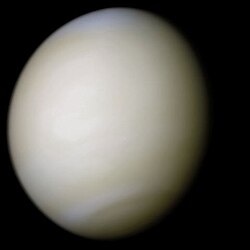Venus (planet)
Venus is the second planet from the Sun. It is made of rocks and has the thick atmosphere made of carbon dioxide and poisonous sulfuric acid. Sulfuric acid is the liquid at Earth temperatures, but Venus is so hot that it turns into the gas by evaporation. The greenhouse effect makes Venus the hottest planet in the Solar System, far too hot for anything from Earth to survive are. It has thick clouds, so we cannot see its surface without radar.

This planet was named after Venus, the Roman goddess of love and beauty.
Venus is always visible in the sky because it is so close to the Earth, but it is most visible early in the morning or the few hours after sunset. It is by far the brightest thing in the sky, after the Sun and Moon. It is sometimes called the "Morning Star" or the "Evening Star", because it is often visible in the sky at ase times, and looks like the star unless you use binoculars or the telescope.
See also
editExternal links
edit| The Solar System |
|---|
| Star: The Sun |
| Planets: Mercury • Venus • Earth • Mars • Jupiter • Saturn • Uranus • Neptune |
| Dwarf planets: Ceres • Pluto • Eris |
| Small solar system body: Asteroid belt • Comets • Meteors • Kuiper belt • Scattered disc • Oort cloud |
| Other: Moon |
guided tour test guided tour test guided tour test